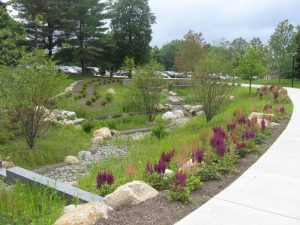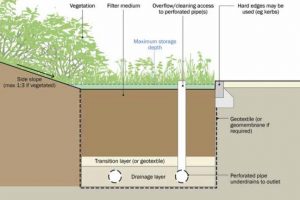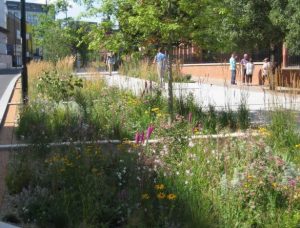Over lockdown, we have all got an appreciation of the importance of having access to green space with a recent study undertaken by ITV finding that 63% of people interviewed said protecting and enhancing green spaces should be more of a priority in the wake of the pandemic.
So, what if we can combine our desire for green space with our drainage needs on new developments.
This week on our deep dive into the world of Sustainable Drainage Systems we are going to look at one of my favourite SuDS features, the bioretention area.
A Bioretention what?
In simple terms, a bioretention area is a shallow, under drained landscaped depression which works by using a combination of engineered soils, planting and filtration in order to reduce runoff rates and improve water quality.
They are incredibly flexible as, unlike some other SuDS components they can be designed in any shape, on a wide range of developments and can be constructed using a variety of different materials.
Figure 1: Example of Bioretention Area

Source: https://greenpare.wordpress.com/2013/07/19/uri-the-greenest-college-in-rhode-island/7-7-09-014/
So, is it just like a normal flower bed?
On the face of it yes, however, there are some key differences which you will need to be aware of if you are thinking of incorporating one on your project.
Figure 2: Typical Cross Section through a Bioretention Area

Source: CIRIA SuDS Manual
The first is that you can’t just use any old topsoil as there is a requirement for the filter medium to not just support healthy plant growth but also be free draining to enable water to pass through the system and prevent saturation. A typical specification is usually a sand-based soil with some organic matter however, it is always best to consult a specialist, such as Bourne Amenity, who will be able to give you some further guidance.
Another thing we need to think about is the actual planting itself. When choosing plants, you should be aiming to use a wide range of species as this will give you a densely vegetated, thriving bed and will enable a good root system to be established. It is also a good idea for you to choose ones that cope well with occasional flooding. This is because your plants will be situated within your temporary storage area that will have been designed to briefly store water during extreme events.
Figure 3: Example of Raingarden Planting

Source: Various
I have included a link to ‘The Raingarden Guide’ at the end of this blog which has a breakdown of some of the plants you could utilise within your bioretention area.
Can they be used anywhere?
Pretty much, whether your project is residential, commercial, or educational, chances are there will be an opportunity to incorporate a bioretention area into some part of your scheme. Also, one of the major benefits of these types of systems compared with other SuDS features is that they also have fantastic retrofit capabilities.
A great example of this is the 2016 Sheffield Grey to Green project which was a 1.6km bioretention scheme constructed in the heart of the city. At the time it was the UK’s largest retro-fit SuDS project and not only did it relieve some of the pressure on the existing sewer network and reduce flooding but it also created a great space which turned a once dull corner of the city into a vibrant public place brimming with wildlife.
Figure 4: Sheffield Grey to Green Project

Source: https://www.susdrain.org/case-studies
OK so they look good and they are flexible, anything else we need to be aware of?
Bioretention areas are excellent at removing pollutants and when properly designed, have the ability to remove approximately 80% of sediments and 90% of nutrients and chemicals from surface water runoff.
When compared to a traditional drainage system which is typically buried, it is also much easier to access for maintenance purposes and can also often be included as part of your landscape maintenance strategy.
Hang on surely with all this planting, they are going to require more maintenance than a traditional system?
OK, so it is slightly more high maintenance than your traditional landscaped area (the SuDS Manual estimates that a typical system will require about 2.5 times more maintenance than a standard planting regime) and it is therefore important that you get a hold on the maintenance requirements early before you get too invested in the system.
As discussed in previous entries, maintenance of the system is important as one of the main causes of failure of the system is due to clogging at the surface which usually materialises in ponding.
Your drainage engineer should be providing you with a maintenance manual as part of the design process, however, some of the regular activities you may need to carry out include:
- Removal of litter, weeds, and other surface debris from the main bioretention area and around the inlets.
- The replacement of any plant to ensure a densely vegetated bed is maintained.
Summary
If you have a site where the existing drainage system is at capacity or if you just want to look at a greener way of traffic calming the use of a bioretention area can bring some real benefits.
If you want to know more about how SuDS could benefit your project why not check out some of our other blog entries or pick up the phone where we will be only too happy to have a chat.
Useful Documents and websites
The Rain Garden Guide (https://raingardens.info/wp-content/uploads/2012/07/UKRainGarden-Guide.pdf)
Susdrain Case Study, Sheffield Grey to Green Phase 1 (https://www.susdrain.org/case-studies/pdfs/suds_awards/006_18_03_28_susdrain_suds_awards_grey_to_green_phase_1_sheffield.pdf)
ITV Pol on Green Space (https://www.itv.com/news/2020-05-07/people-want-to-see-green-spaces-prioritised-after-lockdown-poll).